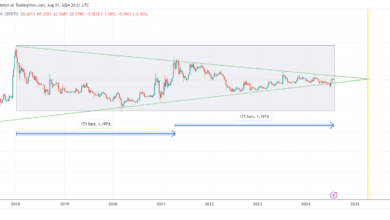Digital Euro: Insights into ECB’s CBDC Developments

The digital euro, a groundbreaking initiative by the European Central Bank (ECB), aims to revolutionize the way we transact within the eurozone. As part of its EU digital euro plans, the ECB envisions this central bank digital currency (CBDC) as a secure and efficient alternative to traditional cash, accessible to all citizens. Recent developments, including insights from the European Commission, have shed light on the design of this innovative digital currency, addressing stakeholder concerns about its functionality and safety. By exploring the potential of the digital euro, we can anticipate a future where digital transactions become seamless across Europe, enhancing financial inclusion. However, how this will all unfold remains uncertain, especially with regards to the involvement of private firms and the limitations the ECB aims to impose on its use.
Exploring the concept of the euro in digital form, the upcoming digital euro represents a shift towards a more technologically integrated financial ecosystem for the EU region. This initiative involves implementing a central bank-issued currency, often labeled as a CBDC, which seeks to harmonize payment processes across member states. The move towards a digitalized euro has raised discussions around various essential factors, including its design and the broader implications for banking institutions. As stakeholders evaluate the significance of a digital payment solution, the broader context of the ECB’s efforts highlights the importance of adapting to future economic realities. The evolution of money towards a digital era epitomizes the changing landscape of finance, inviting innovative solutions that cater to modern consumer needs.
Understanding the ECB’s Digital Euro Initiative
The European Central Bank (ECB) has embarked on a transformative journey with its digital euro initiative, aiming to integrate a central bank digital currency (CBDC) into the eurozone economy. This move is in response to the evolving landscape of digital finances, where cryptocurrencies and fintech solutions are gaining traction. The ECB’s digital euro is not just a technological upgrade; it represents a strategic effort to modernize the monetary system, providing consumers with an efficient and secure alternative to cash. By embracing digital formats, the ECB hopes to reduce transaction costs and increase financial inclusion across member states.
Despite ongoing discussions, significant uncertainties remain surrounding the ECB’s digital euro plans. The implications of a CBDC in Europe extend beyond mere payments; they touch on the nature of monetary sovereignty, privacy concerns, and the future role of banks. As the ECB refines its vision, critical evaluations of its design and operational framework are necessary to address various stakeholders’ concerns, including financial institutions and the general public. The strategic implementation of the digital euro will require collaboration across the European Union, aligning national interests with overarching EU digital currency goals.
Digital Euro as an Alternative to Cash
The digital euro is designed to serve as a viable cash substitute, ensuring that digital transactions can be conducted securely and conveniently across the eurozone. As consumers increasingly favor cashless transactions, the ECB aims to provide a trusted form of currency backed by the authority of the central bank. This digital currency will be inclusive, as it is expected to be available to all citizens within the eurozone, fulfilling a fundamental acceptance requirement. Furthermore, the ECB plans to collaborate with national central banks to facilitate the circulation of the digital euro.
Moreover, an essential aspect of the digital euro is its compatibility with private sector solutions, aiming to create a hybrid ecosystem where both public and private digital currency forms coexist. However, the ECB is keen on maintaining control over the digital euro, which is why considerations such as transaction fees and maximum holdings are under discussion. Limiting the amount an individual can hold in digital euros—recently suggested at 3,000 euros—may be a strategic move to deter large-scale withdrawals from traditional banks, thereby ensuring stability within the financial system.
CBDC Europe: Risks and Challenges Ahead
The rollout of a central bank digital currency in Europe introduces various risks and challenges that must be critically assessed. One of the major concerns surrounding the digital euro is the potential for increased centralization of monetary policy, which might undermine the decentralized nature of economies. Enhanced liquidity risks could arise for commercial banks as customers might prefer to hold their funds in the digital euro rather than traditional deposits, impacting banks’ lending ability and overall financial stability. As such, the ECB is tasked with balancing innovation and security as it navigates these complex waters.
In light of these challenges, banks and financial institutions are encouraged to innovate and develop robust alternatives to the digital euro. The future of banking may heavily rely on embracing tokenized deposits and stablecoins to provide competitive options that satisfy consumer demands for security and efficiency. The message is clear: preparation and proactive measures are critical to ensuring that the banking sector remains resilient amid the challenges presented by a CBDC. Engaging with the economy and civil society is vital to ensuring that the design of the digital euro reflects diverse interests and safeguards against potential pitfalls.
The Role of Technology in Digital Euro Design
The design of the digital euro is interwoven with technology, particularly as discussions around Distributed Ledger Technology (DLT) continue to evolve. While the ECB is contemplating the use of such technologies to enhance transaction transparency and efficiency, it faces a significant hurdle in reconciling the need for central control with the benefits that decentralized technologies can offer. Regardless, any implementation would likely refrain from utilizing a public blockchain due to the inherent risks to central bank authority. Instead, the focus could be on private networks that offer tokenized transactions without the characteristic decentralization found in cryptocurrencies like Bitcoin.
As the digital euro design progresses, it is vital for stakeholders to participate in shaping its technological backbone. The potential utilization of DLT should be carefully evaluated to maintain the ECB’s control over monetary policy while also leveraging technological advancements that can promote secure and efficient transactions. This dual approach can help the ECB ensure that the digital euro is resilient, trustworthy, and meets the evolving needs of Eurozone citizens. Properly executed, the design of the digital euro can set a benchmark for other central banks exploring similar paths.
Banking Sector Adaptation to Digital Currency
The introduction of the digital euro necessitates a significant adaptation from the banking sector. Financial institutions must rethink their operational strategies to accommodate the digital euro’s presence while simultaneously protecting their customer base from migrating to this safer central bank alternative. Conversations around the digital euro must include strategies for banks to innovate swiftly, adopting new technologies such as blockchain and improving current service offerings to enhance customer experience. Embracing technologies like tokenized assets and smart contracts could provide banks with the competitive edge needed to manage their deposits effectively.
Moreover, the evolution of the digital euro presents an opportunity for banks to redefine their roles in the evolving financial landscape. To remain relevant, banks can explore partnerships with fintech providers to build integrated solutions that allow seamless access to both traditional banking services and digital currency management. This synergy can help banks to act as essential intermediaries in a digital euro environment, bridging the gap between consumers and central bank innovations. Preparing for the arrival of the digital euro requires foresight and strategic collaboration to mitigate risks and leverage opportunities presented by this financial revolution.
Civil Society’s Influence on Digital Euro Development
The design and implementation of the digital euro are not solely a technical challenge; they also represent a social and political endeavor that calls for broad engagement from civil society. It is crucial that the perspectives of various stakeholders, including consumers, businesses, and civil rights organizations, are considered during the development phase. By actively soliciting feedback from these groups, the ECB can create a digital euro that not only meets economic goals but also addresses societal concerns about privacy, security, and accessibility. A well-rounded approach will ensure the digital euro serves all segments of the population effectively.
Engaging civil society in discussions around the digital euro can also help to demystify the concept of CBDCs and foster a better understanding among the public. Educational initiatives that explain the benefits and risks associated with the digital euro will be vital in building trust and acceptance. Additionally, transparency in the decision-making process will empower citizens to voice their opinions and contribute to shaping the future of the eurozone’s monetary landscape. It is imperative that as the digital euro progresses, it reflects not just the technical specifications but also the diverse values of society.
Potential Global Impact of the Digital Euro
The digital euro could have far-reaching implications that extend beyond the Eurozone. By establishing a credible digital central bank currency, the ECB may set the benchmark for other economies contemplating a CBDC. The influence of the euro as a major global currency could offer insights and frameworks for how digital currencies can integrate into the international monetary system, potentially challenging the dominance of other currencies like the US dollar. A well-implemented digital euro could enhance Europe’s role in the global economy, providing a secure and efficient alternative for international transactions.
However, the global impact of the digital euro also hangs on the reactions of other major economies and their approaches to CBDCs. As nations observe the ECB’s progress, they will likely engage in competitive innovations of their own, shaping the future trajectory of digital currencies worldwide. Hence, the ECB must not only think locally but also strategically position the digital euro on the global stage, ensuring it is a formidable player among the global financial architectures. Collaboration and cooperation with other nations will be essential to address the challenges and opportunities presented by digital currencies.
Navigating Privacy Concerns with the Digital Euro
As the ECB works on the digital euro, privacy is a significant concern that must be addressed. Given the centralization of transaction data inherent in a CBDC, issues relating to user anonymity and data protection are paramount. Citizens will undoubtedly expect that their transactions remain confidential while benefitting from the advantages of a central bank’s backing. Thus, the challenge lies in designing a digital euro that respects user privacy without compromising anti-money laundering (AML) and know your customer (KYC) requirements.
The ECB’s response to privacy concerns must balance the need for transparency in financial transactions with the personal rights of citizens. Clear guidelines on data handling, storage, and user consent will be vital in maintaining public trust. Engaging in open dialogues with advocacy groups and civil rights organizations can provide insights into how to incorporate privacy features within the digital euro effectively. Ultimately, the approach adopted could serve as a model for other central banks as they develop their digital currencies, highlighting the importance of aligning modern financial systems with evolving societal values.
Future of Financial Transactions with Digital Currency
The advent of the digital euro signals a significant shift in financial transactions within the Eurozone, reimagining how consumers and businesses interact with money. As trust in digital formats rises, transactions may become more streamlined, enabling quicker payments across borders. The implications for e-commerce are profound, as the digital euro could facilitate new business models and enhance consumer experience through instantaneous settlements and lower transaction costs.
Moreover, the transition to the digital euro presents a chance to harness innovative technologies such as smart contracts and artificial intelligence to enhance transaction processes. These advancements can minimize friction in everyday transactions, allowing users to engage more seamlessly with digital payment systems. As the ECB finalizes the design of the digital euro, it will be critical to create a framework that supports innovation while ensuring stability and security, paving the way for a more integrated financial future.
Frequently Asked Questions
What is the digital euro and how does it function as a cash substitute?
The digital euro is a central bank digital currency (CBDC) developed by the European Central Bank (ECB) intended to serve as a widespread means of payment across the eurozone. It aims to provide an alternative to traditional cash and will be widely accessible to the public, with a fundamental acceptance requirement. Additionally, national central banks may be involved in its circulation to ensure usability outside the eurozone.
What are the latest updates from the EU regarding the ECB digital currency?
Recent insights from the European Commission reveal draft legislation on the digital euro, although its implementation remains uncertain. This draft outlines key aspects of the digital euro design, reflecting ongoing discussions about how a digital euro could function and integrate within existing financial systems.
Will the digital euro have programmable features like some cryptocurrencies?
The ECB has stated that the digital euro is not intended to be programmable, aiming to alleviate concerns about potential restrictions such as expiration dates or spending limitations. This decision distinguishes the digital euro from more flexible digital currencies, such as those in China, while addressing the concerns of traditional banks about the attractiveness of digital euro holdings.
How does the ECB plan to manage the risks associated with the digital euro?
To manage risks, the ECB is considering maximum limits on the amount citizens can hold in digital euros—recent discussions suggested a cap of 3,000 euros. Additionally, the involvement of banks in managing digital euro accounts is expected to provide a bridge between the central bank and the public, alleviating concerns over potential bank runs.
Will the digital euro use blockchain technology?
While the ECB has explored the use of Distributed Ledger Technology (DLT) for the digital euro, it will not be based on a public blockchain due to the need for central bank control. Instead, the digital euro may utilize a tokenized structure without the decentralized features typical of cryptocurrencies, ensuring regulatory oversight.
What implications does the digital euro hold for banks and the financial sector?
The introduction of the digital euro could create liquidity risks and affect traditional banking operations, as customers might prefer a safer central bank alternative over bank deposits. Thus, banks are encouraged to develop private alternatives, such as tokenized deposits and stablecoins, to remain competitive and offer viable choices to consumers.
How can society and the economy influence the development of the digital euro?
It is crucial for both the economy and civil society to actively engage in the design phase of the digital euro. This engagement ensures that the digital euro reflects social and political values and addresses public concerns about central bank digital currencies, leading to a more equitable financial system.
| Key Point | Details |
|---|---|
| Digital Euro’s Purpose | Serves as a cash alternative and means of payment throughout the eurozone. |
| ECB’s Control | ECB may develop its own app, but considers using private solutions for transactions. |
| Limitations | Not intended to be programmable, mitigating concerns of spending restrictions. |
| Involvement of Banks | Banks might help manage digital euro accounts to reduce risks of deposit withdrawals. |
| Maximum Limits | Discussion of a cap, possibly set at 3,000 euros per individual for digital euro holdings. |
| Technical Structure | Possible use of Distributed Ledger Technology without a decentralized framework typical of cryptocurrencies. |
Summary
The digital euro represents a significant evolution in the European monetary landscape, aiming to modernize how transactions are conducted in the eurozone. It is designed to serve as a reliable alternative to cash, widely accessible and managed under the auspices of the European Central Bank (ECB). While the digital euro holds promise for enhanced payment solutions, it comes with notable limitations to ensure security and teamwork with existing banking structures. Consequently, banks are urged to innovate and present private alternatives to the ECB’s offering, as the careful development of the digital euro will impact financial structures for both institutions and individuals.



